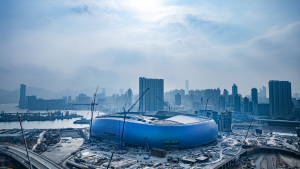In the ever-evolving landscape of infrastructure development, the integration of geospatial and sensor technologies has emerged as a transformative force, redefining the way we survey and map highways. This paradigm shift towards more advanced and accurate methodologies was illuminated in the opening session of the Roads and Highways panel of the 2nd day of the GeoSmart Infrastructure. Dr. Deb Jyoti Pal, the Vice President of Data Product at Geospatial World, inaugurated the session, setting the tone for an exploration into the future of highway infrastructure development.
Javed Sheikh, the Technical Director at QuantaSIP Geomatics Informative Solutions announced that the rollout of a GIS-based toll system is imminent, following a successful pilot on the Mumbai-Pune Highway. He said, “The GNSS based toll system is a significant step towards enhancing efficiency and reducing congestion on highways. Moreover, the decision to phase out Fast Tag in favor of this new system signals a commitment to innovation and embracing technology for smoother traffic management.
A notable highlight of this technological revolution is the concept of Virtual Gantries. These digital checkpoints are poised to redefine the highway experience, streamlining toll collection and vehicle monitoring. This innovation not only optimizes traffic flow but also showcases the potential of geospatial technology to bridge the gap between physical and digital infrastructure.
Streamlining Workflows through 5D BIM
Prashant Patil, an Executive Engineer from the Public Works Department (PWD) Mumbai, shed light on a persistent challenge in the industry – inaccurate Detailed Project Reports (DPRs). He emphasized the need to align workflows with available technology to ensure accurate DPRs. In his view, the next three years will witness the emergence of Building Information Modeling (BIM) as a multi-billion-dollar industry in India. The integration of 5D BIM solutions, which encompass Digital Twin, CAD, BIM, and GIS, promises to be a game-changer in highway construction and management.
“There are 16 Metro Rail Corporations using 5D BIM from last 2-5 years and around 80 New Airports where 5D will be a mandate. Indian Railways upcoming 5000 stations renovation will also use 5D BIM” he said.
Amit Agarwal, the AVP & HOD at Systra, highlighted the synergy between remote sensing data and GIS platforms for conducting environmental impact studies. This confluence of technologies enables a comprehensive assessment of the ecological footprint of transport infrastructure projects, promoting sustainable development.
He said, “Data acquisition, a crucial aspect of surveying and mapping, has witnessed a revolution through the adoption of cutting-edge technologies. Survey technologies like Total Station, GNSS (Global Navigation Satellite System), Unmanned Aircraft Systems, and LiDAR (Light Detection and Ranging) have enabled faster and more precise data collection. These technologies not only enhance accuracy but also empower engineers to make informed decisions in real-time.”
Accuracy, Time and Cost: The Need of the Hour for Sustainable Infrastructure Development
The CORS system plays a crucial role in improving the accuracy and reliability of various geospatial and surveying applications. Surveyors, engineers, and other professionals can use CORS data to enhance the precision of their work, especially in applications that require accurate positioning, such as construction, mapping, and navigation. By using data from multiple CORS stations, users can correct for errors caused by factors like atmospheric conditions and satellite geometry, resulting in more accurate measurements and improved overall surveying quality.
The CEO of NeoGeo, GV Sreramam, stressed the three essential forces that drive successful survey and data processing: Accuracy, Time, and Cost. He said, “CORS (Continuously Operating Reference Stations) system acts as a binding factor for surveys. This technology ensures uniform and accurate data across highway corridors while expediting data delivery and scalability.”
Sunil Krishnan, the Business Head at Pan India, shared insights into how Trimble Technology is revolutionizing the construction industry. He said, “By providing a Single Digital Model/BIM (Building Information Modeling) accessible to all stakeholders, from designers to surveyors and site engineers, construction processes are streamlined and communication is enhanced. This technology bridges gaps between various roles, ensuring everyone is empowered with the right data and accurate information.”
The session unveiled a promising future for highway infrastructure development, one where geospatial and sensor technologies play a pivotal role. From GIS-based toll systems to Virtual Gantries, accurate DPRs to 5D BIM solutions, and advanced survey technologies to Single Digital Models, this convergence of innovation is reshaping the industry landscape. As India gears up for the next wave of infrastructure growth, these technologies are poised to propel the nation towards more efficient, sustainable, and digitally empowered highways.









